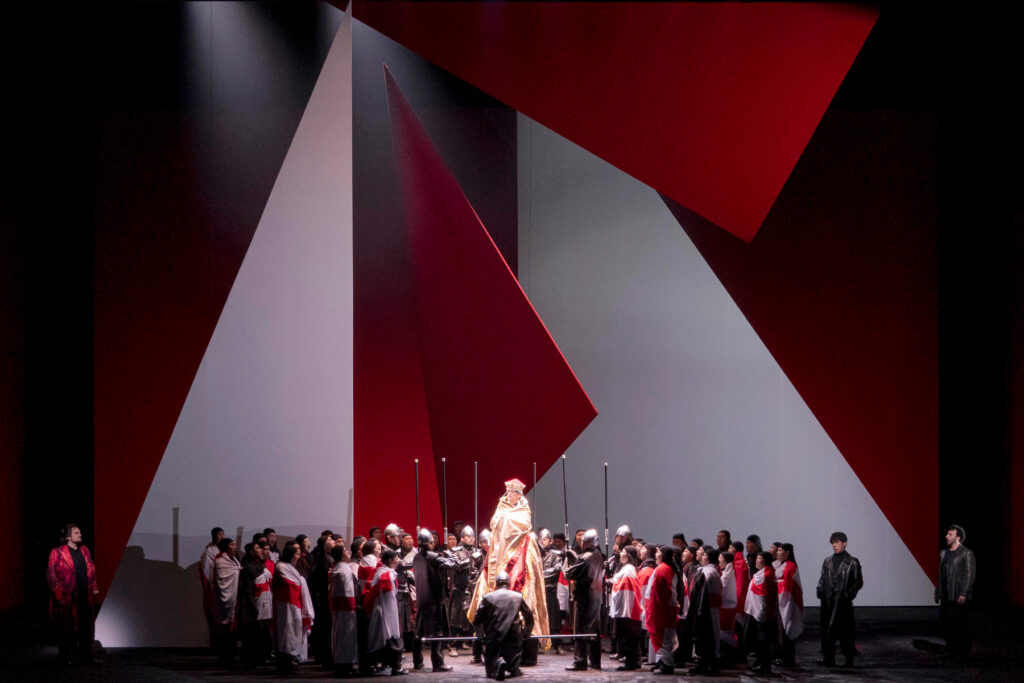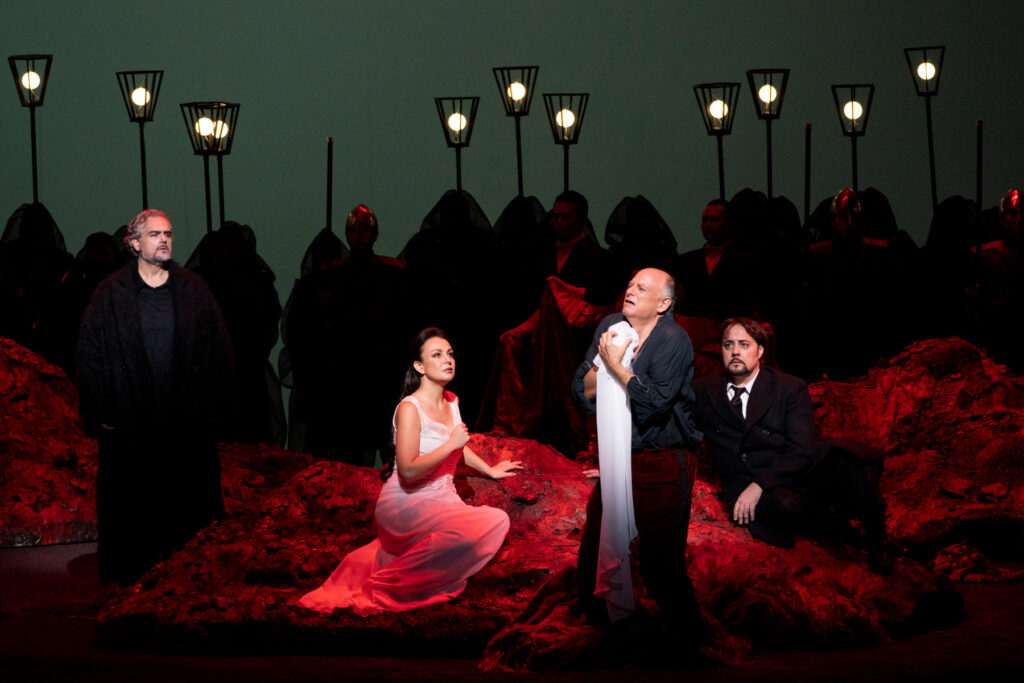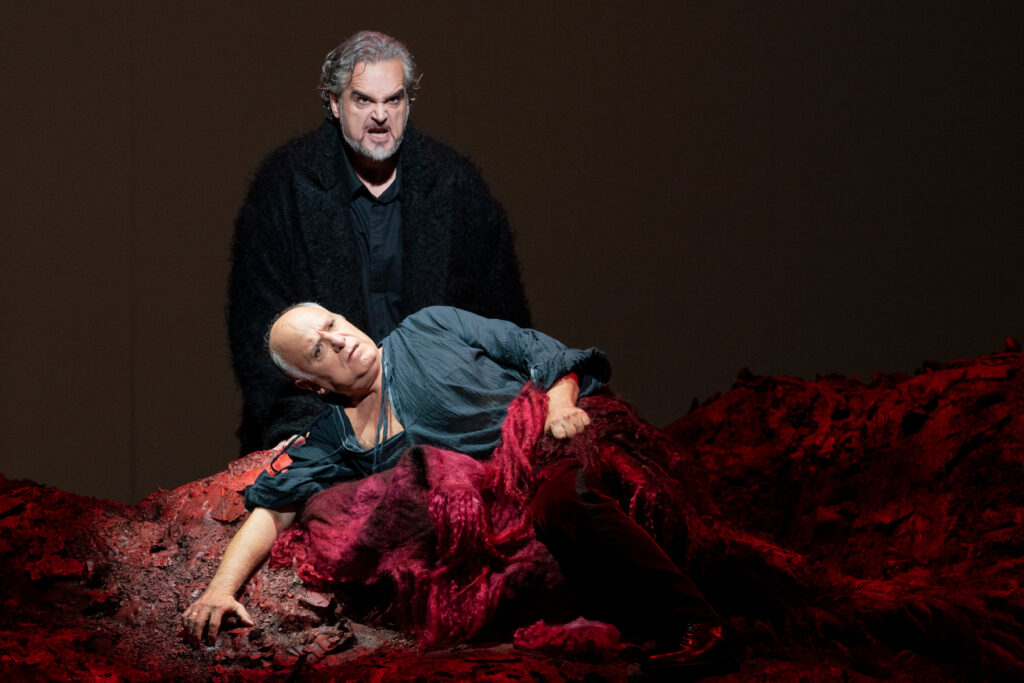To some people, Simon Boccanegra (1857, rev. 1881) is one of Verdi’s finest musical masterpieces, yet both admirers and detractors regard it as based on one of his most problematic librettos. A favorite of conductors, this piece poses a real challenge to directors. In this new production commissioned by the New National Theatre, Tokyo in a co-production with the Finnish National Opera and Madrid’s Teatro Real, and seen on November 23, Pierre Audi tries to forget “architectural decoration in favor of a visual world that mirrors or contrasts the psychic inner drive of the central characters” (Production Note). This visual world is impressively realized by his artistic partner, Anish Kapoor, who associates the loneliness and death-driven journey of the titular role with that of the Greek philosopher Empedocles.

Kapoor’s minimalistic design is a visual journey dominated by three colors: red and white (the colors of the Genoa flag) and black, atmospherically lit by Jean Kalman. The prologue suggests a harbor with the triangular shapes of sails; the remainder of the opera is dominated by an upside-down sculptural suggestion of a volcano threatening from above, producing for the last act a field of lava that opens up onto a new dawn, a black sun. To anyone expecting the drama of the corsair-turned-doge in 14th-century Genoa to unfold in an oceanic blue setting (such as Giorgio Gallione’s 2007 production), this red-white-black production might seem a bit too abstract/symbolic or futuristic, even apocalyptic. The immense black sun hanging over the deceased doge and his grieving family – along with the Genovese people clad in PPE-like costumes – left a troubling, lasting impression.
The cast is outstanding. As Boccanegra, Roberto Frontali – who turned 65 during the dress rehearsal – consolidates his position as one of today’s finest Verdi baritones with his rich, sonorous voice and the nuanced tone of his performance. Looking surprisingly young and rakish in the prologue, he portrayed the newly elected doge with much dignity in the main opera. The duets with his long-lost daughter were sung touchingly with restrained passion. The last scene in which he expires – with his nuanced colors and mesmerizing sotto voce – was undoubtedly the afternoon’s emotional high-water mark.

Irina Lungu brings a resonant voice to Boccanegra’s daughter Amelia (Maria) in an affecting portrayal. Her creamy voice sounded at times like that of Mariella Devia, and her middle- and lower registers were not unlike Elina Garanca’s. It was a pity that her entrance aria, “Come in quest ora bruna,” sounded a bit occluded, presumably due to the stage direction. Initially she was lying face up for a good three minutes (during the prelude) as if she were dead – meant to symbolize her deceased mother. Then, just a few bars before the first note, she wakes up, as if resurrected, and immediately starts singing. Even Mirella Freni, complaining in the 1970s at having been directed to sing this aria at the far end of the stage, was at least allowed to sing upright from the beginning. Lungu’s voice found more carrying power when joined by her beloved father. Her gorgeous, statuesque silhouette stole almost every scene.
As Boccanegra’s nemesis Fiesco, Riccardo Zanellato is perfectly poised with his cavernous low notes. His impassioned opening aria and duets with the doge were a delight for the ears. Luciano Ganci’s ardent and strong-willed Gabriele, Amelia’s husband-to-be, enamored the audience with his scintillating bright voice, slightly overpowering his lover: an impressive house debut. Of the smaller roles, Simone Alberghini portrayed Paolo most convincingly in the dramatic cursing scene at the end of Act 1. Shingo Sudo is an assured Pietro throughout.

In the pit, Kazushi Ono leads a well-tuned Tokyo Philharmonic Orchestra, vividly enacting everything from the sea waves and birdsongs (despite the volcanic staging) to the characters’ emotional outbursts in a truly Verdian manner. Ensemble numbers and singing from the chorus are uniformly excellent, although their Renaissance-style coiffure with unmatching modern suits in Act 1 might have been a bit distracting to certain Japanese: the supposed Genovese councilors looked like the members of a Showa Era all-male folksong group. That said, it worked as a sort of comic relief in this highly serious drama, whether intended or not.
Natsuko Hirakura
Simon Boccanegra – Roberto Frontali, Amelia (Maria Boccanegra) – Irina Lungu, Jacopo Fiesco – Riccardo Zanellato, Gabriele Adorno – Luciano Ganci, Paolo Albiani – Simone Alberghini, Pietro – Shingo Sudo, Un capitano dei balestrieri – Toshiaki Murakami, Un’ancella di Amelia – Ryoko Suzuki
Director – Pierre Audi, Conductor – Kazushi Ono, Set Design – Anish Kapoor, Costume Design – Wojciech Dziedzic, Lighting Design – Jean Kalman
New National Theatre Chorus, Tokyo Philharmonic Orchestra
New National Theatre Tokyo, Thursday 23rd November 2023
All photographs © Rikimaru Hotta